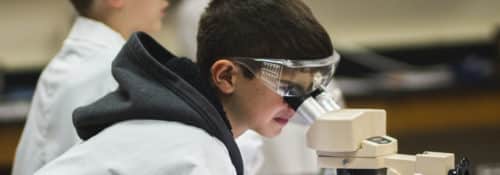
How to Run an Elementary Science Lab
By Avery Lacey, ’20
 Dr. Colleen Lutz teaches 5th grade at Founders Classical Academy of Leander in Texas. After receiving her doctorate in veterinary medicine, homeschooling her children, and teaching in a hybrid and now a classical school, she has years of experience with hands-on science. “Science is one of those subjects where students are inspired because they can discover, explore, and invent,” Lutz says. She shared her thoughts and ideas on how to encourage this inspiration at the 2019 BCSI summer teacher training:
Dr. Colleen Lutz teaches 5th grade at Founders Classical Academy of Leander in Texas. After receiving her doctorate in veterinary medicine, homeschooling her children, and teaching in a hybrid and now a classical school, she has years of experience with hands-on science. “Science is one of those subjects where students are inspired because they can discover, explore, and invent,” Lutz says. She shared her thoughts and ideas on how to encourage this inspiration at the 2019 BCSI summer teacher training:
- Foster Curiosity: “Anything you can do in your classroom to inspire wonder and interest is a good thing,” Lutz says. She displays natural objects, such as a jawbone, seashells, feathers, a turtle shell, and a cat skull, in class. “I set these things up in my classroom at the beginning of the year to spark their interest and to get them curious about things.”
- Encourage Student Involvement: Once her students saw Dr. Lutz’s example, they joined in her wonder. “My students brought me their treasures from the natural world all year long,” Dr. Lutz remembers from a particular class. She added her students’ snakeskins, birds’ nests, and honeycombs to her collection throughout the year.
- Prepare the Students: Before you enter the lab, explain the experiment or concepts in the classroom first. “The first time they enter a new room with all these super cool things, they are distracted and can’t focus on the task at hand,” Dr. Lutz explains.
- Prepare Yourself: “Preparation is key,” Lutz says. “Do the experiment yourself first—don’t just think it through in your head and expect that you’ll be fine.”
- Make it Serious: “I send home a permission slip and a lab safety agreement,” Lutz says. I want the kids to understand that this is a privilege and the things we are using are very expensive, so they can’t have bad behavior.”
- Have a Seating Chart: Lutz advises teachers to construct a chart based on both behavior and ability. “It’s nice to have them help each other,” she says.
“This sounds like a lot of work, and it is,” Lutz says. “But, when students hold an actual heart in their hand or they see a chemical reaction in front of them, it’s something they just don’t forget. It has a very big impact on them.” With preparation, creativity, and a sense of wonder, any teacher can encourage the same in his or her students.